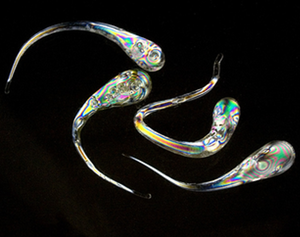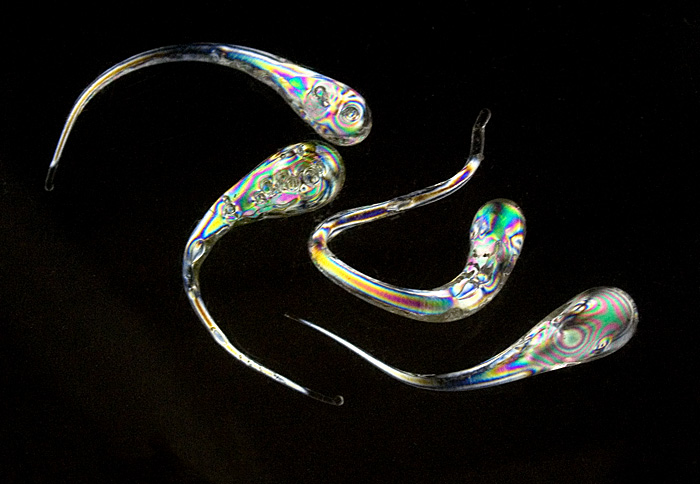Controlling Persistent Stress in Glass
Glass in products such as smart phone screens is made tougher by internal stress that is locked in during the formation process. In Physical Review Letters, a research team presents a model for this “residual stress” at the molecular scale. They combined experiments, simulations, and theory for a system of microscopic beads that mimics a glass. The team found that, contrary to some predictions, residual stress can be permanent, rather than decaying to zero over time, strengthening the case that glasses are not just highly viscous liquids. In addition, they precisely controlled the amount of residual stress in their glass, providing the first systematic demonstration that the history of stresses on a material can determine its properties.
A famous example of residual stress in glass is the Prince Rupert’s drop (or Dutch tear). Dropping molten glass into cold water forms a tadpole-shaped object where the “head” can withstand blows from a hammer, but the whole thing explodes if the thin tail is cut. When it first hits the water, the external surface cools and hardens rapidly, preventing the inside from shrinking when it cools, and the resulting tension leads to the head’s high strength. Through trial and error, engineers have found ways to toughen glass and even metal alloys by careful application of stress during fabrication.
Despite its usefulness, little is known about the microscopic details of residual stress. One popular model of disordered behavior holds that a glass is essentially a very viscous liquid, so residual stresses should eventually “relax” to zero, as molecules move around in response to internal forces. But “this theoretical picture is incomplete,” says Thomas Voigtmann of the Institute of Materials Physics in Space at the German Aerospace Center in Cologne. He and his colleagues have developed a multifaceted picture that incorporates experiments, simulations, and calculations, all focused on a specific case of residual stress.
The experiments used submicron-sized plastic beads floating in liquid (a colloid) as a stand-in for molecules in a glass. Individual beads are essentially trapped in potential wells, or so-called cages, defined by their nearest neighbors. At low bead concentration, the mixture behaves like a dense liquid or gel, but above a certain density, the beads can become frozen while remaining disordered, like molecules in a glass. Changing the concentration allowed Voigtmann and his colleagues to switch easily between liquidlike and glasslike states.
To create so-called shear stress, the team placed the colloid into a standard liquid-measurement device with a circular bottom and a shallow-sloped conical top, with its point touching the bottom. While the bottom plate remained fixed, they rotated the cone a short distance and then stopped it. Then they measured the force on the top cone generated by the stressed glass. In the liquidlike state, this force disappeared after a few seconds, as the beads could easily move to relieve the stress. However, in the glasslike state, the force decreased and then leveled off at a fixed value. The stark contrast in behavior argues against the notion that glasses are just high-viscosity liquids.
In different trials, the researchers varied the cone rotation rate (“shear rate”) and found that the amount of residual stress decreased with increasing shear rate. This result demonstrated that glass can exist in a variety of states depending on its mechanical history. Such memory effects are well known with respect to thermal history—using different heating and cooling rates—but less so in purely mechanical situations.
To better understand this behavior, the team performed molecular dynamics simulations that tracked the motion of individual beads. Based on the simulations, and using a sophisticated glass theory [1], the researchers built a model to explain how mechanical memory is stored. In the model, nearest-neighbor cages are destroyed during the shearing, temporarily freeing beads to move toward equilibrium in response to internal stresses. The faster the shear, the more destructive it is, and therefore the more rapidly the liberated beads can move. But the cages quickly reform, locking in the remaining stress. The amount of residual stress at this stage acts as a form of memory because it depends on the shear rate the glass had previously experienced.
Mike Cates from the University of Edinburgh in the UK says that understanding residual stresses is important for many practical uses of glass. “What is original and highly interesting about this work is that they use a clean experimental protocol,” and this, he says, allows direct comparison between experiments, simulations, and calculations. He is struck by the fact that different final states can be selected by changing the shear rate. Such rate dependence is not found in similar materials, such as polymer melts, he says.
–Michael Schirber
Michael Schirber is a Corresponding Editor for Physics Magazine based in Lyon, France.
References
- M. Fuchs and M. E. Cates, “Theory of Nonlinear Rheology and Yielding of Dense Colloidal Suspensions,” Phys. Rev. Lett. 89, 248304 (2002)
More Information
Mystery of Prince Rupert’s drop (video, shows explosion in slow motion) by Smarter Every Day
Prince Rupert’s drop demonstration by Museum of Glass, Tacoma, Washington
The physics of colloidal glasses by Eric Weeks, Emory University





